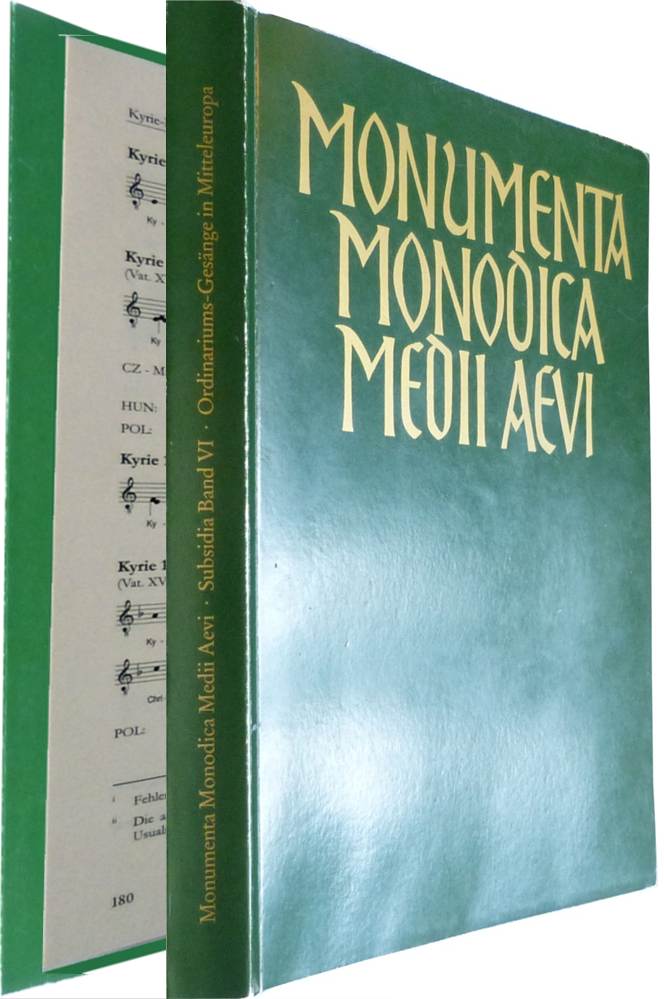Catalogue and corpus of ordinary chants
- Founded in the 1970s, this project began with transcribing the ordinary chants of three representative graduals from Hungary.
- Expanded from 1993, it continued to transcribe further ordinary sources from Hungary.
- Aims:
- To review the whole Hungarian repertory of ordinary chants and compare them with the European chant corpus in foreign catalogues.
- To compile a more complete corpus of chants from Central Europe by processing Hungarian, Bohemian/Moravian, Austrian and Polish sources.
- It contains the details of over 100 source materials each with over 200 items and transcriptions, amounting to a total of over 2000 chants.
- Presentation of the research findings and publication of the collection in a chant-catalogue form occurred in 2009:

Gábor Kiss, Ordinariums-Gesänge in Mitteleuropa.
Repertoire-Übersicht und Melodienkatalog.
Monumenta Monodica Medii Aevi, Subsidia Band VI
(Kassel–Basel, etc.: Bärenreiter, 2009)
Further details
Also begun in the 1970s, along with occasional transcription of certain items connected with the corpus of graduals, was separate, systematic transcription of the ordinary chants. In the first stage, initiated by Benjamin Rajeczky, transcription of ordinary items from only three Hungarian sources that can only partly be considered representative was completed (see below). The transcription was done by Éva Pintér. This core of the collection did not include the Agnus Dei melodies.
- Futaki gradual (Istanbul, Topkapı Sarayı Müzesi, 2429)
- Bakócz gradual (Esztergom, Főszékesegyházi Könyvtár, MS I. 1 a-b)
- Gradual from Kassa/Košice (Budapest, OSzK, Clmae 172a-b)
Sizeable expansion and development of this material for publication purposes was begun in 1993 by Zsuzsa Czagány, Gábor Kiss and Ágnes Papp. The aim was to review the Hungarian ordinary sources comprehensively and compare them with international catalogues (by Melnicki, Bosse, Thannabaur, and Schildbach). Attention was not confined to gathering all variants. It soon became clear from dealing with the genre that no full picture could be obtained of the variants or even the corpus of chants used in the country without processing all accessible sources. Regular discoveries of hitherto unregistered chants led to a recognition that international ordinary catalogues could not offer a faithful picture of the region, because of the small number of Hungarian sources in them hardly typical of the tradition. Gábor Kiss gave on behalf of the working group a lecture on early experiences with cataloguing, to the Cantus Planus meeting held in Eger in 1993:
- „A Repertory of Mass Ordinaries in Eastern Europe”, in Cantus Planus, Papers Read at the 6th Meeting, Eger, Hungary, 1993, ed. László Dobszay (Budapest: Hungarian Academy of Sciences, Institute for Musicology, 1995), 585–600.
Thereafter Gábor Kiss continued the work as his specific subject. The expansion involved systematic transcribing and cataloguing of all Hungarian sources found in domestic and foreign libraries. (All of these, which vary in the degree of care taken in transcribing them, are held by Gábor Kiss; much of the material is also available in computer-transcribed form.) Based on the experiences and the fact that the source materials for the region found in international catalogues are uneven, plans arose for publishing a catalogue of Central European ordinary chants. Extensive research began with the aim of familiarization with the ordinary traditions of neighbouring countries (the Bohemian lands, Poland, and Austria). The resulting catalogue and corpus covered over 100 sources each containing data and transcriptions of over 200 ordinary chants, i. e. over 2000 chants. Plans include preparing and presenting a computerized musical transcription of the repertory. Alongside several studies recounting experiences gained, the catalogue appeared in the Monumenta Monodica series in 2009: Gábor Kiss, Ordinariums-Gesänge in Mitteleuropa. Repertoire-Übersicht und Melodienkatalog. Monumenta Monodica Medii Aevi, Subsidia Band VI (Kassel–Basel, etc.: Bärenreiter, 2009).







